Asus ROG Phone 8 Pro Review: Snapdragon 8 Gen 3 For The Win
Asus ROG Phone 8 Pro Review: Voice, Data And Benchmark Performance
ROG Phone 8 Pro Voice and Data
We've had issues with voice quality on Asus phones in the past, but the ROG Phone 8 Pro has lived up to its name by functioning as a telephone. Voice calls are clear and we haven't seen any calls drop, which is an improvement over last year's ROG Phone 7.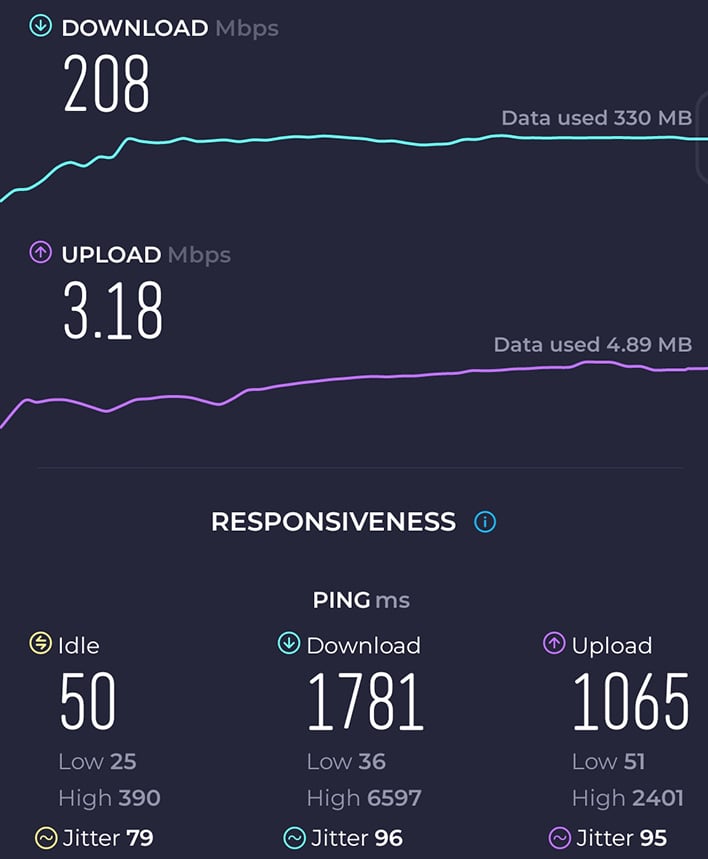
As far as data goes, the ROG Phone 8 Pro is typical of most unlocked 5G phones. It has a good selection of sub-6GHz bands but no support for millimeter wave frequencies. That's not a huge loss as these networks are only available in small bubbles around urban areas. We tested the 5G speeds with the ROG Phone 8 Pro on T-Mobile's network, and it easily matched the speeds we see on Samsung devices.
Asus ROG Phone 8 Pro Performance
The Asus ROG Phone 8 and 8 Pro are among the first devices to launch with Qualcomm's latest Snapdragon 8 Gen 3 chip. This processor introduces a new core design, featuring a Cortex-X4 Prime Core, five A720 cores at two different clock speeds, and a pair of low-power A520 cores. This new architecture is supposed to be faster and more efficient. That's born out in some of our benchmarks, but the changes appear to throw off some single-threaded tests.We'll get to the testing specifics in a moment, but in terms of daily usage, the ROG Phone 8 Pro is ludicrously fast. Apps open instantly, games run on the highest settings, and the whopping 24GB of RAM keeps days worth of apps in memory. The phone is more likely to close apps to save power than it is to run out or memory.
Asus ROG Phone 8 Pro Geekbench Results
Geekbench is a cross-platform benchmark that simulates real-world processing workloads in image processing and particle physics calculation scenarios. We tested all of the smartphones featured here with Geekbench's single and multi-core workloads.
Asus ROG Phone 8 Pro PCMark For Android Results
UL's PCMark for Android is an excellent suite of tests if you want to benchmark a wide range of tasks on a handset -- things like image and video editing, as well as lighter-duty, everyday workloads such as email and web browsing. When you see the test running live, it's clear the scripted application tests are carefully selected and tuned to make use of the mobile platform in a very controlled way.
This test also produces some odd results on the Snapdragon 8 Gen 3. The full-speed "X-mode" setting tops the charts, but the dynamic mode falls behind older phones like the Galaxy Z Fold 3. Again, we suspect the high-speed cores aren't being utilized in this benchmark correctly.
Asus ROG Phone 8 Pro AnTuTu 8 Benchmarks
AnTuTu’s latest benchmark returns a number of metrics ranked with somewhat nebulous scores, rather than frame rates or time to complete. Here we're running the latest version of AnTuTu across multiple Android devices. AnTuTu returns four top level performance results which are all included here: CPU, RAM, 3D, UX (or User Experience), along with a total score.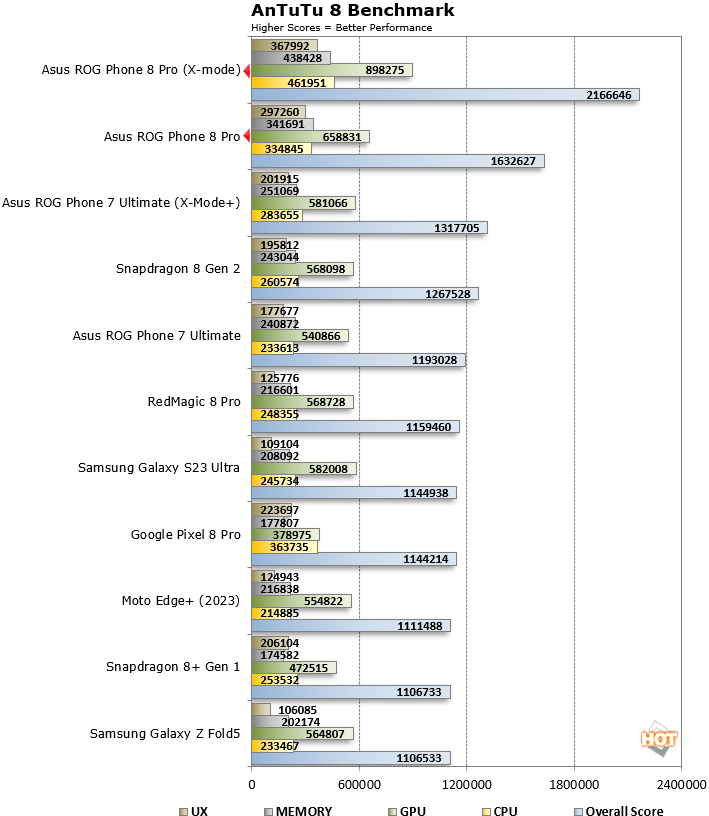
This time, there's no core confusion. The AnTuTu benchmark shows the ROG Phone 8 Pro way out in the lead, both in dynamic mode and X-mode. It's not even close, with the ROG Phone 8 Pro dynamic mode beating the ROG 7 Ultimate in X-mode by about 25%.
Asus ROG Phone 8 Pro Graphics And Gaming Benchmarks Results
Now, let's take a look at how the ROG Phone 8 Pro stacks up in GFXBench, which has been one of the standard mobile graphics/gaming performance benchmarks for years. To ensure that display refresh (v-sync) and resolution aren't limiting factors, we're comparing off-screen test results here. GFXBench tests OpenGL ES graphics workloads and we're specifically testing OpenGL ES 2.0 and 3.0, as well as Vulkan in the latest iterations.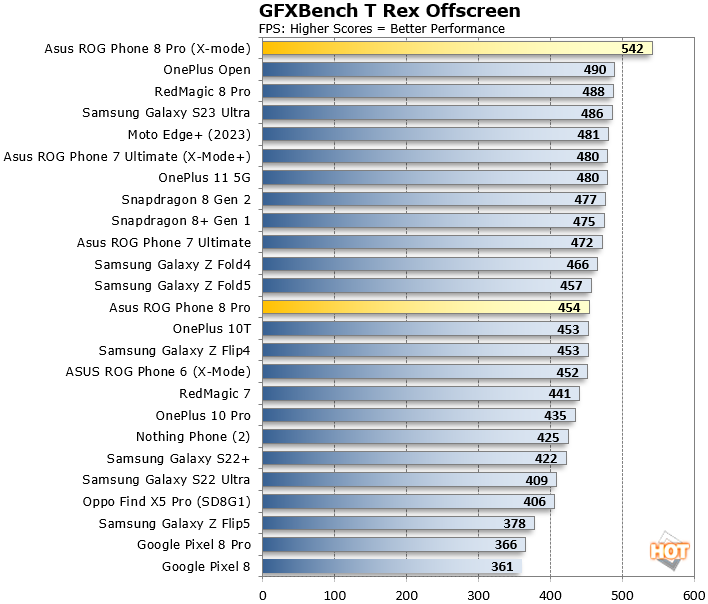
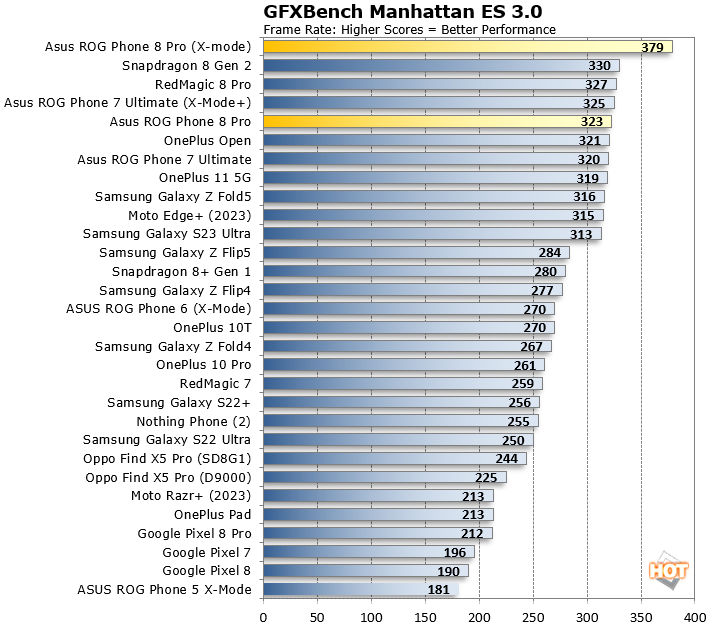
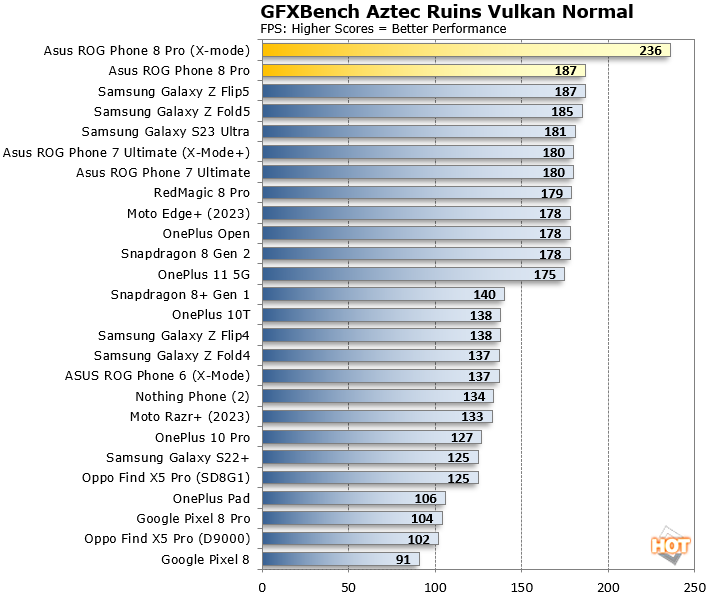
The T-rex and Manhattan tests use older graphics technology, so the updated Snapdragon chip doesn't take full advantage. In X-mode, the ROG Phone 8 Pro beats every other device we've tested. In dynamic, it runs in the middle of the pack. In the Vulkan-based Aztec test, the ROG Phone wins regardless of performance setting.
Asus ROG Phone 8 Pro 3DMark Slingshot Tests
UL's 3DMark Sling Shot is one of several modules in the 3DMark mobile suite. Unlike previous gen 3DMark mobile tests, Sling Shot is a much more advanced OpenGL ES 3.1 and Metal API-based benchmark that employs more advanced rendering techniques, like volumetric lighting, particle illumination, multiple render targets, instanced rendering, uniform buffers, and transform feedback. We're running this test in off-screen mode once again to remove display resolution differences from the equation. This allows us to compare cross-platform results more reliably.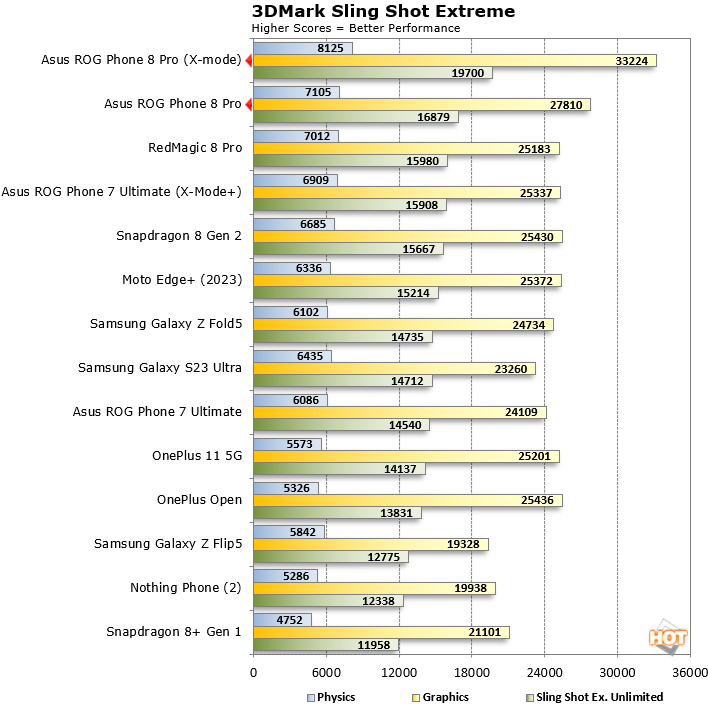
The ROG Phone 8 Pro wins this one hands-down, surpassing the record set by The RedMagic 8 Pro gaming phone last year. The X-mode score is particularly impressive, adding about a third to the RedMagic 8 Pro's score.
Asus ROG Phone 8 Pro Wild Life Benchmark Tests
3DMark's Wild Life benchmark is newer and more demanding than Slingshot, and it allows powerful devices to shine. And the ROG Phone 8 Pro shines very brightly.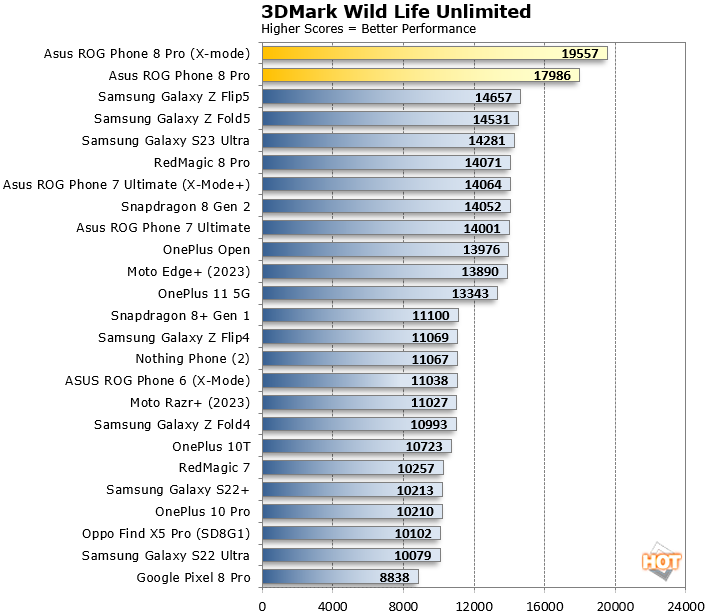
In both performance modes, the ROG Phone 8 Pro easily beats every other phone in our database. Samsung's overclocked Snapdragon chip from 2023 made the Z Flip 5 and Z Fold 5 the devices to beat, but the ROG Phone 8 Pro leaves them in the dust.
As devices heat up, they throttle the SoC speed. Using the Wild Life stress test, we can simulate what it's like to play a game for long periods. We found that Asus' new cooling system works surprisingly well to pull heat away from the SoC. During the 20-minute Wild Life stress test, the ROG Phone 8 Pro maintained almost full speed, throttling less than 10%. While the Snapdragon chip stays cool enough, other parts of the phone get extremely toasty.
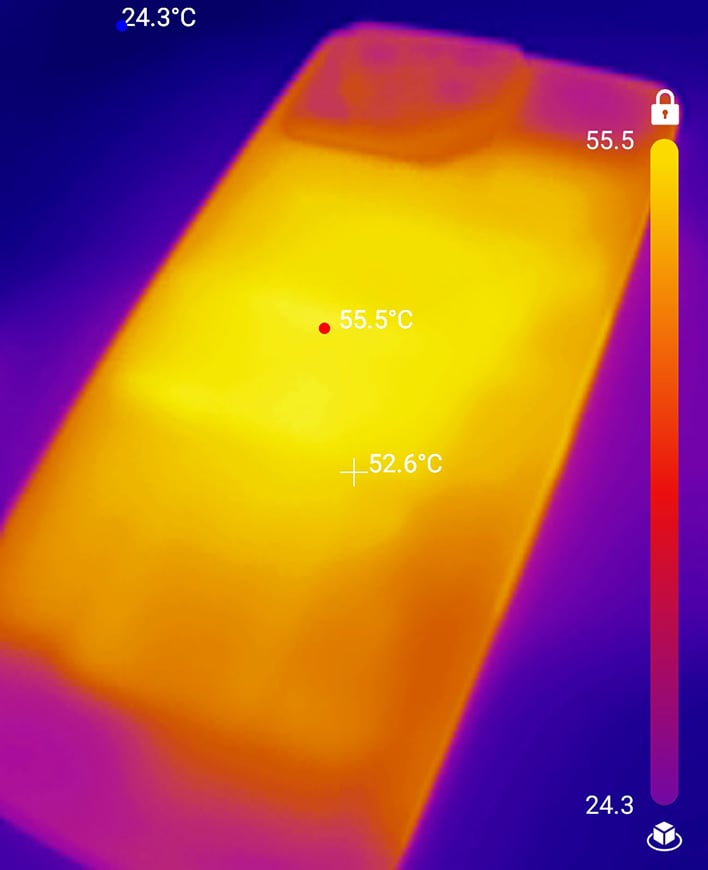
This phone is literally hot hardware.
As you can see above, we found that the glass back of the phone reaches a staggering 131 degrees Fahrenheit (about 55 Celsius). That's hot enough to burn your skin in 30 seconds! The metal frame also gets uncomfortably hot, but it's a few degrees shy of actually burning you. On the bright side, this shows that Asus' conduction cooling stack works. Heat from the SoC is being transferred to the back, right where the AeroActive fan sits. Given that, we expected to see the fan make a difference in the same test.
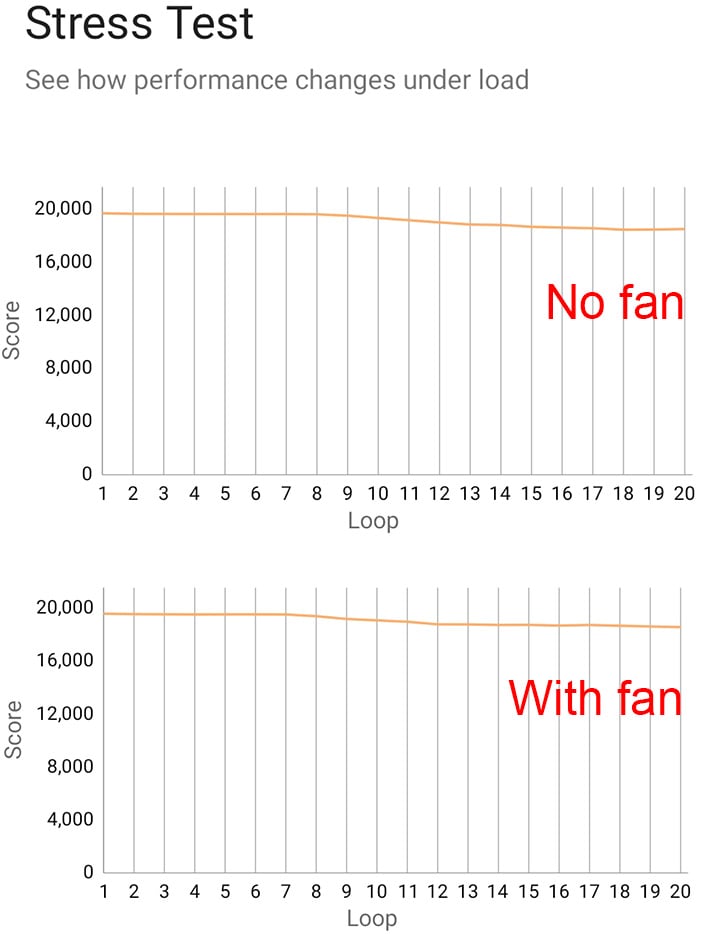
As you can see above, attaching the fan keeps the SoC slightly cooler. However, the fan's performance gain is barely 1%. The upshot: the fan keeps the body of the phone cooler. So, counterintuitively, it's more comfortable to play games with the fan clamped onto the phone simply because it keeps it from getting so scorching hot. The performance is not appreciably better with the cooling fan, though.





